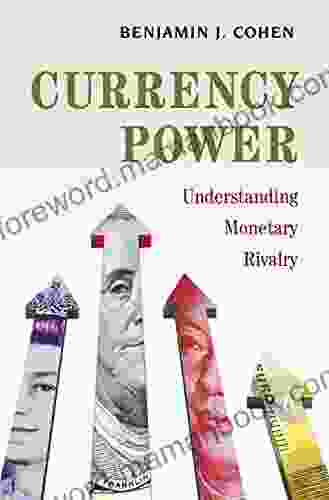Currency Power: Understanding Monetary Rivalry in a Globalized Economy

In the realm of international finance, the power of currencies is a subject that has fascinated economists and policymakers for centuries. As the backbone of global trade and investment, currencies play a pivotal role in shaping economic outcomes and influencing the power dynamics between nations.
The value of a currency is determined by a complex interplay of factors, including economic growth, inflation, interest rates, political stability, and global demand. A strong currency generally reflects a healthy and prosperous economy, while a weak currency can indicate economic challenges or instability.
4.5 out of 5
| Language | : | English |
| File size | : | 3029 KB |
| Text-to-Speech | : | Enabled |
| Screen Reader | : | Supported |
| Enhanced typesetting | : | Enabled |
| Word Wise | : | Enabled |
| Print length | : | 296 pages |
Currency Power and Economic Dominance
Historically, currency power has been closely linked to economic dominance. The most powerful currencies in the world have typically been those issued by countries with strong and stable economies. For example, the British pound sterling held global dominance for much of the 19th and early 20th centuries, reflecting the United Kingdom's industrial and financial prowess.
In the post-World War II era, the US dollar emerged as the dominant currency, backed by the strength of the American economy and its role as the world's largest creditor. The dollar became the de facto global reserve currency, held by central banks and international organizations as a store of value and a means of settling international transactions.
Monetary Rivalry in the 21st Century
However, the dominance of the US dollar has been challenged in recent years by the rise of other major currencies, such as the euro, the Chinese yuan, and the Japanese yen. As these economies have grown and developed, their currencies have gained prominence and played an increasingly important role in global finance.
This monetary rivalry reflects the shifting global economic landscape and the growing power of emerging markets. Countries like China and India are seeking to assert their economic influence by promoting the international use of their currencies. They are increasing their foreign exchange reserves, investing in foreign markets, and establishing bilateral trade agreements that denominate transactions in their own currencies.
The Euro: A Challenge to the Dollar's Dominance
The euro, introduced in 1999, has been a significant challenger to the US dollar's global dominance. The European Union, with its large and prosperous economy, has sought to establish the euro as a rival reserve currency. The euro has gained acceptance in international trade and investment, and it is widely held by central banks around the world.
However, the eurozone's recent economic challenges, including the Greek debt crisis and the euro debt crisis, have raised questions about the currency's long-term stability. The euro's future as a rival to the US dollar will depend on the ability of the European Union to address its economic and political challenges.
The Chinese Yuan: A Rising Star
The Chinese yuan, also known as the renminbi, has emerged as another major contender in the global currency race. China's rapid economic growth and its increasing global trade have made the yuan a highly sought-after currency. The Chinese government has been gradually internationalizing the yuan by allowing its use in international trade settlements and investing in foreign markets.
However, the yuan's internationalization faces challenges. China's capital controls and its tightly managed exchange rate system limit the free flow of the currency. The Chinese government is also criticized for its lack of transparency and predictability in its currency management policies.
The Japanese Yen: A Safe Haven
The Japanese yen has traditionally been seen as a safe haven currency during times of economic uncertainty. Japan's low interest rates and strong trade surplus have made the yen a popular investment for foreign investors seeking stability. The Japanese government has also intervened in the currency markets to support the yen's value.
However, the yen's status as a safe haven currency has been tempered by Japan's economic challenges, including its aging population and declining productivity. The yen's future role in global finance will depend on the ability of the Japanese government to address these economic headwinds.
Implications of Currency Rivalry
Currency rivalry has significant implications for global economic stability and the balance of power between nations. A strong currency can provide a country with numerous advantages, including:
- Reduced borrowing costs
- Improved trade competitiveness
- Increased foreign investment
- Enhanced international influence
On the other hand, a weak currency can have negative consequences, such as:
- Increased inflation
- Reduced purchasing power
- Difficulty servicing foreign debt
- Diminished international prestige
Currency rivalry can also lead to tensions between countries. For example, the US government has accused China of manipulating the value of the yuan to gain an unfair trade advantage. Such accusations can undermine trust and cooperation between nations.
Currency power is a complex and evolving phenomenon that reflects the shifting global economic landscape. As economies rise and fall, the power of their currencies changes accordingly. The ongoing monetary rivalry between the US dollar, the euro, the Chinese yuan, and the Japanese yen will continue to shape the global financial system and influence the power dynamics between nations.
Understanding currency power is essential for policymakers, businesses, and investors alike. By recognizing the factors that drive currency value and the implications of currency rivalry, we can better navigate the risks and opportunities in the globalized economy.
References
- Aizenman, J., & Glick, R. (2017). International reserve currencies and monetary rivalry. Journal of International Money and Finance, 77, 158-177.
- Branson, W. H. (2010). The future of the dollar. Brookings Papers on Economic Activity, Spring 2010, 147-208.
- Eichengreen, B., & Temin, P. (2008). Currency dominance and the international monetary system. Oxford Economic Papers, 60(3),342-365.
- International Monetary Fund. (2020). World Economic Outlook. Retrieved from https://www.imf.org/en/Publications/WEO
- Obstfeld, M. (2019). The rise and decline of the US dollar. SUERF Policy Note, No. 79, December 2019.
4.5 out of 5
| Language | : | English |
| File size | : | 3029 KB |
| Text-to-Speech | : | Enabled |
| Screen Reader | : | Supported |
| Enhanced typesetting | : | Enabled |
| Word Wise | : | Enabled |
| Print length | : | 296 pages |
Do you want to contribute by writing guest posts on this blog?
Please contact us and send us a resume of previous articles that you have written.
 Top Book
Top Book Novel
Novel Fiction
Fiction Nonfiction
Nonfiction Literature
Literature Paperback
Paperback Hardcover
Hardcover E-book
E-book Audiobook
Audiobook Bestseller
Bestseller Classic
Classic Mystery
Mystery Thriller
Thriller Romance
Romance Fantasy
Fantasy Science Fiction
Science Fiction Biography
Biography Memoir
Memoir Autobiography
Autobiography Poetry
Poetry Drama
Drama Historical Fiction
Historical Fiction Self-help
Self-help Young Adult
Young Adult Childrens Books
Childrens Books Graphic Novel
Graphic Novel Anthology
Anthology Series
Series Encyclopedia
Encyclopedia Reference
Reference Guidebook
Guidebook Textbook
Textbook Workbook
Workbook Journal
Journal Diary
Diary Manuscript
Manuscript Folio
Folio Pulp Fiction
Pulp Fiction Short Stories
Short Stories Fairy Tales
Fairy Tales Fables
Fables Mythology
Mythology Philosophy
Philosophy Religion
Religion Spirituality
Spirituality Essays
Essays Critique
Critique Commentary
Commentary Glossary
Glossary Bibliography
Bibliography Index
Index Table of Contents
Table of Contents Preface
Preface Introduction
Introduction Foreword
Foreword Afterword
Afterword Appendices
Appendices Annotations
Annotations Footnotes
Footnotes Epilogue
Epilogue Prologue
Prologue Will Adams
Will Adams Jean Heller
Jean Heller C Y Croc
C Y Croc Christine Mc Sween
Christine Mc Sween Edward Marston
Edward Marston Rosy Aindow
Rosy Aindow Linda Schiller Hanna
Linda Schiller Hanna B Nishaaa
B Nishaaa Charlie Eaton
Charlie Eaton Roberto Ricci
Roberto Ricci Bill Peterson
Bill Peterson Frank R Stockton
Frank R Stockton Danielle S Allen
Danielle S Allen Cleo Wade
Cleo Wade Julia March
Julia March Z J Cannon
Z J Cannon David Petersen
David Petersen Maria Semple
Maria Semple Robert Brightwell
Robert Brightwell Patricia M Cunningham
Patricia M Cunningham
Light bulbAdvertise smarter! Our strategic ad space ensures maximum exposure. Reserve your spot today!
 Ernesto SabatoFollow ·13.1k
Ernesto SabatoFollow ·13.1k Asher BellFollow ·9.8k
Asher BellFollow ·9.8k Brayden ReedFollow ·11.7k
Brayden ReedFollow ·11.7k Felipe BlairFollow ·7.1k
Felipe BlairFollow ·7.1k Jay SimmonsFollow ·8.5k
Jay SimmonsFollow ·8.5k Abe MitchellFollow ·7.6k
Abe MitchellFollow ·7.6k Leslie CarterFollow ·8.3k
Leslie CarterFollow ·8.3k Francisco CoxFollow ·4.5k
Francisco CoxFollow ·4.5k

 Chase Simmons
Chase SimmonsCompletely Unputdownable Serial Killer Thriller:...
Prepare yourself for an...

 Bruce Snyder
Bruce SnyderThe Likeness: A Spine-Chilling Crime Novel by Tana French
Step into the Shadows of a Twisted...

 Langston Hughes
Langston HughesDiscover the Enchanting World of Cute Animals: A Journey...
Welcome to the...

 Adrian Ward
Adrian WardDelving into the Profoundly Disturbing World of No Longer...
In the realm of horror manga, Junji Ito...

 Edgar Allan Poe
Edgar Allan PoeIllustrated Magical Recipes For Wizards And Witches:...
In the realm of witchcraft and wizardry,...

 Joe Simmons
Joe SimmonsMetamorphoses: A Masterpiece of Ancient Greek Mythology...
Metamorphoses, a seminal work of...
4.5 out of 5
| Language | : | English |
| File size | : | 3029 KB |
| Text-to-Speech | : | Enabled |
| Screen Reader | : | Supported |
| Enhanced typesetting | : | Enabled |
| Word Wise | : | Enabled |
| Print length | : | 296 pages |












